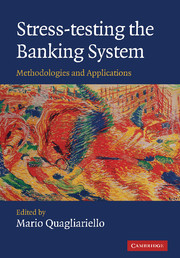Book contents
- Frontmatter
- Contents
- List of figures
- List of tables
- List of boxes
- List of contributors
- Foreword
- Acknowledgements
- Introduction
- Part I Fundamentals
- Part II Applications
- 8 Stress-testing credit risk: the Italian experience
- 9 Stress-testing US banks using economic-value-of-equity (EVE) models
- 10 A framework for integrating different risks: the interaction between credit and interest rate risk
- 11 Stress-testing linkages between banks in the Netherlands
- 12 An integrated approach to stress-testing: the Austrian Systemic Risk Monitor (SRM)
- 13 From macro to micro: the French experience on credit risk stress-testing
- 14 Stress-testing in the EU new member states
- 15 Cross-border macro stress-testing: progress and future challenges for the EU
- 16 Stress-testing at the IMF
- Conclusions
- Index
- References
13 - From macro to micro: the French experience on credit risk stress-testing
from Part II - Applications
Published online by Cambridge University Press: 18 December 2009
- Frontmatter
- Contents
- List of figures
- List of tables
- List of boxes
- List of contributors
- Foreword
- Acknowledgements
- Introduction
- Part I Fundamentals
- Part II Applications
- 8 Stress-testing credit risk: the Italian experience
- 9 Stress-testing US banks using economic-value-of-equity (EVE) models
- 10 A framework for integrating different risks: the interaction between credit and interest rate risk
- 11 Stress-testing linkages between banks in the Netherlands
- 12 An integrated approach to stress-testing: the Austrian Systemic Risk Monitor (SRM)
- 13 From macro to micro: the French experience on credit risk stress-testing
- 14 Stress-testing in the EU new member states
- 15 Cross-border macro stress-testing: progress and future challenges for the EU
- 16 Stress-testing at the IMF
- Conclusions
- Index
- References
Summary
Main features and objectives of the French stress-testing framework
The stress-testing approach adopted by the Commission Bancaire – Banque de France is based on a reduced form credit risk model, where the capacity of a borrowing agent to repay his debt is determined by the difference between the value of his assets and the nominal value of his debt. Hence, the link with stress-testing exercises can be easily made through two complementary steps. First, the asset is modelled as a variable that adjusts over time under the realisation of random shocks, which can either be idiosyncratic (agent-specific) or systemic (macroeconomic) in nature. In that context, our stress test will implicitly consist of quantifying the impact of these shocks – or risk factors – to the asset value of the borrower. Second, according to Merton (1974), the comparison of the asset value to the nominal debt value determines the default of the borrower. The default occurs when the value of the debt exceeds the value of the assets. Therefore, the measure of credit risk, over a one-year horizon, is the probability of default (PD). The Basel 2 regulatory framework – namely the Internal Ratings Based (IRB) approach for credit risk – provides us with an appropriate structure for stress-testing. Compliant with Vasicek (2002), our stress-testing exercises will aim at assessing how systemic and/or idiosyncratic risk factors may affect the dynamic of PDs in banks' loan portfolios.
- Type
- Chapter
- Information
- Stress-testing the Banking SystemMethodologies and Applications, pp. 238 - 260Publisher: Cambridge University PressPrint publication year: 2009
References
- 1
- Cited by

